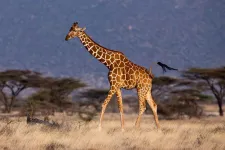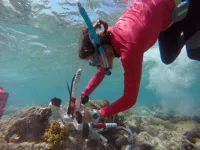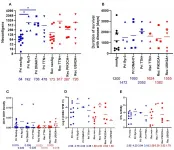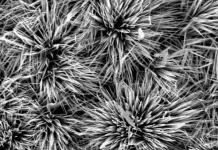INFORMATION:
The trouble of being tall
2021-03-17
(Press-News.org) The giraffe is a truly puzzling animal. With its exceptional anatomy and suite of evolutionary adaptations, the giraffe is an outstanding case of animal evolution and physiology. Now, an international team of researchers from the University of Copenhagen and Northwestern Polytechnical University in China have produced a high-quality genome from the giraffe and investigated which genes are likely to be responsible for its unique biological features.
The extraordinary stature of the giraffe has led to a long list of physiological co-adaptations. The blood pressure of the giraffe, for instance, is twice as high as in humans and most other mammals to allow a steady blood supply to the lofty head. How does the giraffe avoid the usual side effects of high blood pressure, such as severe damage to the cardiovascular system or strokes?
The team discovered a particular gene - known as FGFRL1 - that has undergone many changes in the giraffe compared to all other animals. Using sophisticated gene editing techniques they introduced giraffe-specific FGFRL1 mutations into lab mice. Interestingly, the giraffe-type mice differed from normal mice in two important aspects: they suffered less cardiovascular and organ damage when treated with a blood pressure increasing drug, and they grew more compact and denser bones.
- "Both of these changes are directly related to the unique physiological features of the giraffe - coping with high blood pressure and maintaining compact and strong bones, despite growing them faster than any other mammal, to form the elongated neck and legs.", says Rasmus Heller from the Department of Biology, University of Copenhagen, one of the lead authors on the study.
Giraffe's can't get no sleep
While jumping out of bed for (some) humans might be an effortless and elegant affair, this is definitely not the case for the giraffe. Merely standing up is an a lengthy and awkward procedure, let alone getting up and running away from a ferocious predator. Therefore, giraffes have evolved into spending much less time sleeping than most other mammals.
- Rasmus Heller elaborates: "We found that key genes regulating the circadian rhythm and sleep were under strong selection in giraffes, possibly allowing the giraffe a more interrupted sleep-wake cycle than other mammals".
In line with research in other animals an evolutionary trade-off also seem to be determining their sensory perception, Rasmus continues:
- "Giraffes are in general very alert and exploit their height advantage to scan the horizon using their excellent eyesight. Conversely, they have lost many genes related to olfaction, which is probably related to a radically diluted presence of scents at 5m compared to ground level".
A model of evolutionary mechanisms--and perhaps even human medicine?
These findings provide insights into basic modes of evolution. The dual effects of the strongly selected FGFRL1 gene are compatible with the phenomenon that one gene can affect several different aspects of the phenotype, so called evolutionary pleiotropy. Pleiotropy is particularly relevant for explaining unusually large phenotypic changes, because such changes often require that a suite of traits are changed within a short evolutionary time. Therefore, pleiotropy could provide one solution to the riddle of how evolution could achieve the many co-dependent changes needed to form an animal as extreme as a giraffe. Furthermore, the findings even identifies FGFRL1 as a possible target of research in human cardiovascular disease.
- "These results showcase that animals are interesting models, not only to understand the basic principles of evolution, but also to help us understand which genes influence some of the phenotypes we are really interested in - such as those related to disease. However, it's worth pointing out that genetic variants do not necessarily have the same phenotypic effect in different species, and that phenotypes are affected by many other things than variation in coding regions.", says Qiang Qiu from Northwestern Polytechnical University, another lead author on the study.
The results have just been published in the prestigious scientific journal, Science Advances.
ELSE PRESS RELEASES FROM THIS DATE:
Algae growing on dead coral could paint a falsely rosy portrait of reef health
2021-03-17
Washington, DC-- Algae colonizing dead coral are upending scientists' ability to accurately assess the health of a coral reef community, according to new work from a team of marine science experts led by Carnegie's Manoela Romanó de Orte and Ken Caldeira. Their findings are published in Limnology and Oceanography.
Corals are marine invertebrates that build tiny exoskeletons, which accumulate to form giant coral reefs. Widely appreciated for their beauty, these reefs are havens for biodiversity and crucial for the economies of many coastal communities. But they are endangered by ocean warming, seawater ...
Mobility data used to respond to COVID-19 can leave out older and non-white people
2021-03-17
Information on individuals' mobility--where they go as measured by their smartphones--has been used widely in devising and evaluating ways to respond to COVID-19, including how to target public health resources. Yet little attention has been paid to how reliable these data are and what sorts of demographic bias they possess. A new study tested the reliability and bias of widely used mobility data, finding that older and non-White voters are less likely to be captured by these data. Allocating public health resources based on such information could cause disproportionate harms to high-risk elderly and minority groups.
The study, by researchers at Carnegie Mellon University (CMU) and Stanford University, appears in the Proceedings of the ...
Oncotarget: Genomic and neoantigen evolution in head and neck squamous cell carcinoma
2021-03-17
Oncotarget published "Genomic and neoantigen evolution from primary tumor to first metastases in head and neck squamous cell carcinoma" which reported that prior work has characterized changes in the mutation burden between primary and recurrent tumors; however, little work has characterized the changes in neoantigen evolution.
These authors characterized genomic and neoantigen changes between 23 paired primary and recurrent head and neck squamous cell carcinoma (HNSCC) tumors.
Within these tumors, they identified 6 genes which have predicted neoantigens in 4 or more patients.
Within HNSCC tumors examined in this Oncotarget ...
Inexpensive tin packs a big punch for the future of supercapacitors
2021-03-17
A sustainable, powerful micro-supercapacitor may be on the horizon, thanks to an international collaboration of researchers from Penn State and the University of Electronic Science and Technology of China. Until now, the high-capacity, fast-charging energy storage devices have been limited by the composition of their electrodes -- the connections responsible for managing the flow of electrons during charging and dispensing energy. Now, researchers have developed a better material to improve connectivity while maintaining recyclability and low cost. ...
A deep dive into cells' RNA reality
2021-03-17
(BOSTON) ¬-- Human cells typically transcribe half of their roughly 20,000 genes into RNA molecules at any given time. Just like with proteins, the function of those RNA species not only relies on their abundance but also their precise localization within the 3D space of each cell. Many RNA molecules convey gene information from the cell's nucleus to the protein-synthesizing machinery distributed throughout the cytoplasm (messenger RNAs or mRNAs), others are components of that machinery itself, while still different ones regulate genes and their expression, or have functions that remain to be discovered. Importantly, many diseases including cancer and neurological diseases have signatures that appear as changes in the abundance and distribution of RNAs.
To enable the analysis ...
The a7 protein is ready for its close-up
2021-03-17
DALLAS - March 17, 2021 - UT Southwestern researchers have identified the structure of a key member of a family of proteins called nicotinic acetylcholine receptors in three different shapes. The work, published online today in Cell, could eventually lead to new pharmaceutical treatments for a large range of diseases or infections including schizophrenia, lung cancer, and even COVID-19.
Nicotinic acetylcholine receptors are members of a broader super-family of proteins called Cys-loop receptors that function as ion channels on cell surfaces and are found in the membranes of many cell types. When the right molecule settles ...
Three times the gains
2021-03-17
From climate change and carbon emissions to biodiversity and global hunger, humanity faces so many challenges that tackling them quickly is a daunting task. One solution that potentially addresses multiple issues could provide the impetus society needs to make significant progress.
An international team of 26 authors, including six at UC Santa Barbara, has just published a study in the prestigious journal Nature offering a combined solution to several of humanity's most pressing challenges. It is the most comprehensive assessment to date of where strict ocean protection can contribute ...
Suicide risk prediction models could be cost-effective in clinical practice
2021-03-17
BOSTON - There are several effective interventions to reduce the risk of suicide, the tenth-leading cause of death in the United States, but difficulties in identifying people at risk for suicide and concerns about the potentially high costs of suicide-prevention strategies have hampered their wider use.
But as researchers at Massachusetts General Hospital (MGH) demonstrate, statistical suicide risk prevention models could be implemented cost-effectively in U.S. health care systems and might help save many lives each year.
By evaluating data on the incidence of suicide and suicide attempts, the costs to society and the health care system of suicide, and the cost and effectiveness of suicide risk-reduction interventions, Eric ...
Global warming helps invasive species flourish - study models likely combined effects on ecosystems
2021-03-17
Increased global temperatures help invasive species establish themselves in ecosystems, new research led by a Swansea University bioscientist has shown.
The study, published by the Royal Society, gives an insight into the probable combined effects of species invasions, which are becoming more common, and global warming.
Climate warming and biological invasions result in the loss of species. They also alter the structure of ecosystems and the ways in which species interact.
While there is already extensive research on how climate change and invasions affect ...
Protecting the ocean delivers a comprehensive solution for climate, fishing and biodiversity
2021-03-17
London, UK (17 March 2021)--A new study published in the prestigious peer-reviewed scientific journal Nature today offers a combined solution to several of humanity's most pressing challenges. It is the most comprehensive assessment to date of where strict ocean protection can contribute to a more abundant supply of healthy seafood and provide a cheap, natural solution to address climate change--in addition to protecting embattled species and habitats.
An international team of 26 authors identified specific areas that, if protected, would safeguard over 80% of the habitats for endangered marine species, and increase fishing catches by more than eight million metric tons. The study is also the first to quantify the potential release of carbon dioxide into the ocean ...





